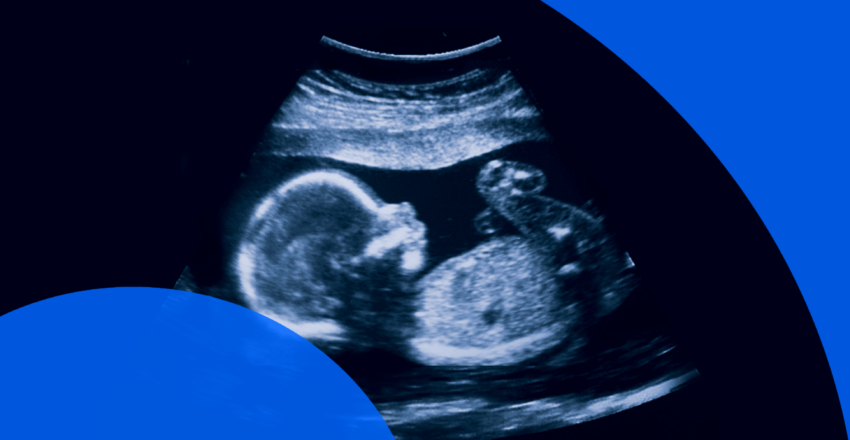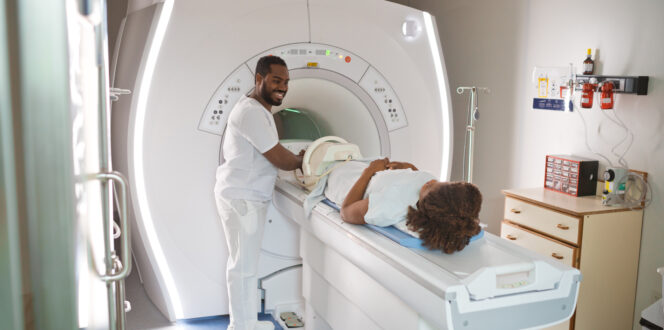How to Read a Pregnancy Ultrasound Report: Decoding Common Terminology

Fetal ultrasounds are a standard prenatal screening tool and medical imaging test used to monitor your health and the health of your baby during pregnancy.
While pregnancy ultrasounds are a reliable way to track and measure your baby’s progress, reviewing your ultrasound report can be daunting. Pregnancy ultrasound reports often include acronyms and medical terminology that the average person may not recognize and knowing how to read ultrasound numbers and measurements can be intimidating.
If you’re experiencing anxiety waiting to review your ultrasound imaging test results with your OBGYN, family doctor or midwife, this article can help you decode the abbreviated medical language and terms in your report.
By understanding the terms in your ultrasound, you can stress less before your appointment and have confident, informed conversations with your healthcare team.
How does a pregnancy ultrasound work?
During your fetal ultrasound examination, a trained technician called a sonographer will use a hand-held device called a transducer to create and capture sound waves. Too high pitched for human ears to hear, those sound waves travel through your body and bounce off different structures in different ways. The ultrasound machine detects and uses these signals to create an image of the position and shape of your growing pregnancy. These captured images are then interpreted by a radiologist.
There are two main types of ultrasound procedures done during pregnancy:
- Transabdominal scan (TAS): A sonographer will squeeze gel onto your belly and then run the transducer over the surface of your skin to capture the fetal anatomy of your growing baby.
- Transvaginal scan (TVS): A sonographer will insert a lubricated wand into your vagina to capture more detailed images of your uterus, ovaries and fallopian tubes, allowing for a closer look at your pregnancy and determining any early pregnancy complications.
Early in your pregnancy, you’ll likely have both an abdominal ultrasound and transvaginal ultrasound, since the embryo is so small that the transducer successfully captures more details inside the vaginal canal than it can outside the abdomen. From the second trimester onwards, you’ll likely only have abdominal ultrasounds.
How to read a fetal ultrasound report
What does BPD mean on an ultrasound? What about CRL? Here’s an alphabetical list of the most common medical acronyms you’ll encounter when reviewing your pregnancy ultrasound results, with an explanation of each.
AC (Abdominal circumference):
The measurement of the fetus’s abdomen used to assess fetal growth and development.
AF (Amniotic fluid):
A clear liquid that surrounds the fetus during pregnancy. Contained in the amniotic sac, AF helps cushion the fetus, allowing for safe movement and regulating environmental temperature. AF can be measured using the Amniotic Fluid Index at any time after the 24-week mark of a pregnancy.
BPD (Biparietal diameter):
A standard used to assess fetal growth and development by measuring the distance between two sides of a fetus’ head. What does BPD mean for your ultrasound? BPD can help your practitioner determine gestational age when measured between 14 and 20 weeks of pregnancy.
CPR (Cerebroplacental ratio):
An obstetric tool used to measure fetal growth and adverse pregnancy outcomes by assessing cardiac output. CPR is typically measured within 2 weeks of delivery to determine placental sufficiency before delivery.
CRL (Crown-rump length):
A measurement of the embryo or fetus from the top of its head to the bottom of its torso used to estimate gestational age. CRL is used to assess age between weeks 6 and 13 of pregnancy, after which other measurements like BPD and head circumference (HC) may be more accurate.
EDD (Estimated date of delivery):
A calculation to determine the most likely date of spontaneous natural birth. EDD can be determined by reviewing ovulation and menstruation dates prior to conception or by examining the size of the uterus through a pelvic exam.
EFW (Estimated fetal weight):
EFW is a measurement determined by assessing the size and measurements of various parts of a fetus, including the head circumference (HC), abdominal circumference (AC) and femur length (FL). EFW can be determined at any point after the 10-week mark of a pregnancy.
FGR (Fetal growth restriction):
Is defined as a low fetal weight less than the 10th percentile in weight for gestational age, taking into consideration the growth potential of the fetus. Depending on the fundal height—the distance between the pubic bone and the top of the uterus—FGR may be assessed throughout the pregnancy.
FHM (Fetal heart rate monitoring):
Monitoring fetal heart rate movements allows your healthcare provider to assess the health of the fetus. The fetus’ FHM can be assessed internally using a transvaginal ultrasound in early pregnancy or externally using a Doppler ultrasound during later stages of pregnancy or labor.
FL (Femur length):
A measurement of the length of the fetus’ thighbone used to help estimate fetal growth and assess development. FL is measured during the second and third trimesters of pregnancy.
GA (Gestation age):
This measurement determines the age of the pregnancy and helps assess the health of the mother and fetus. GA can be determined by reviewing the LMP date, fundal height and ultrasound images.
GS (Gestational sac):
The gestational sac is a fluid-filled structure that surrounds and protects the embryo during the first weeks of pregnancy. Measuring the diameter of the GS during an ultrasound can help determine gestational and fetal age and assess the health of the pregnancy. This measurement is called the mean gestational sac diameter (MSD) and may be taken in the first trimester.
HC (Head circumference):
A measurement of the circumference of the fetus’ head used to determine fetal growth and development in combination with BPD, FL and AC measurements. HC is measured during the second and third trimesters of pregnancy.
LGA (Large gestational age):
LGA is a descriptor indicating that a newborn baby weighs more than usual for the length of pregnancy. LGA indicators can be assessed after the 20th week of pregnancy and may be determined by ultrasound or monitoring the mother’s weight gain during pregnancy.
LMP (Last menstrual period):
Date of the mother’s last menstrual period is used to determine the date of delivery and may be requested at the beginning of pregnancy to determine the length of gestation and approximate delivery date.
MSD (Mean gestational sac diameter):
The measurement of the GS using an ultrasound. This measurement determines the gestational age and expected due date of a pregnancy.
NT (Nuchal translucency):
The measurement of the amount of fluid behind the neck of a developing fetus. NT can be assessed by ultrasound between the 11th and 13th week of pregnancy and helps determine the risk of Down Syndrome and other genetic conditions in the developing fetus.
OFD (Occipital-frontal diameter):
Used to assess the growth and development of the fetus, the OFD is the measurement between the back of the head and the forehead of the fetus. This measurement is taken during the second and third trimesters of pregnancy and can be used in combination with BPD to determine the shape of the head.
SGA (Small for gestational age):
SGA is a descriptor indicating that a newborn baby weighs less than usual for the length of pregnancy. SGA indicators can be assessed after the 20th week of pregnancy and may be determined by ultrasound, checking placental blood flow or monitoring the mother’s weight gain during pregnancy.
How PocketHealth can help you access and understand your fetal ultrasound report
You’ll likely be eager to review your prenatal ultrasound images and results. PocketHealth gives you quick access to your pregnancy ultrasound images and reports, as soon as they’re released by the hospital imaging department or imaging clinic—often before your scheduled appointment with your OBGYN, referring family doctor or midwife. You can also securely store your results to any device and share the high-quality images with friends and family during all stages of your pregnancy.
The medical terms, acronyms and assessments found in your ultrasound report won’t be light reading, but Report Reader can help. Report Reader provides definitions for the medical terminology in your report, making it easier for you to understand your results and feel informed and confident at your follow-up appointments.
You can also get personalized insights based on your report. MyCare Navigator spotlights follow-up suggestions and can help you determine the best questions to ask at your next appointment using the Ask My Doctor feature. You’ll always arrive ready to participate in your care at your next prenatal appointment.
Feel confident and in control of your pregnancy
Pregnancy is often an exciting time but can feel nerve-wracking because many of the changes happening to your body are outside of your control. What you do have control over is understanding how your pregnancy progresses, including a better understanding of the medical acronyms and terminology in your ultrasound report.
Gaining knowledge of the medical terms in your report and understanding what your ultrasound images are capturing can ease any anxieties you might have about your baby’s growth, their health and your own wellbeing. More importantly, the knowledge you acquire also allows you to feel more informed and confident throughout your pregnancy when speaking with any member of your healthcare team.
How PocketHealth works
Learn more about how you can use PocketHealth to access and share your pregnancy ultrasound images and results.
Published: February 8, 2023
Trusted by more than 800+ hospitals and clinics.



















